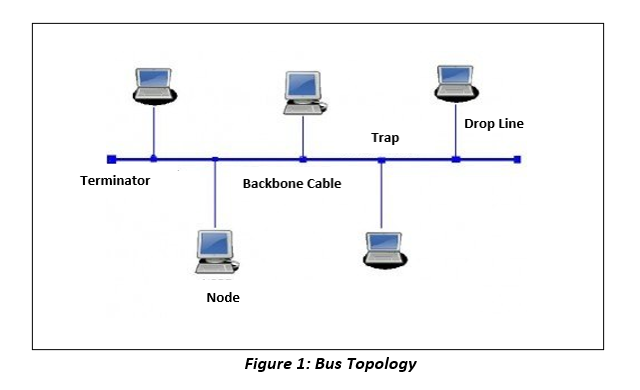Network Topology
Network topology refers the physical or logical combination of the devices in the network. There are 2 types of topologies. One is physical network topology and logical network topology. Physical network topology refers the physical signal transmission medium and logical network topology refers the manner in which data passes through the network between devices regardless of the physical link between the devices. In this article we are discuss about the physical network topologies such as bus, ring, star, mesh, tree, and hybrid topology.
Bus Topology
In bus topology all the devices are connected to the single communication line called backbone cable through the drop lines. When we connect the drop cable with the backbone cable, we use a special device called tap. In a bus topology each end called as “Node” and a node connected with a PC/a network devices(printer/scanner) or a server. There are two terminators connected to the both end of the backbone cable for transfer the signal from one end to another end. The data is sent in only one direction until it reaches the expected destination device.

Advantages of Bus Topology
· Since all the devices are directly connected to the single cable, it requires less cable length and unused of the third communication device like hub, the initialization cost is low.
· Due to a drop cable needs to be connected with backbone cable it is easy to install and expand the network.
· Due to each device has a dedicated drop cable, the failure of a node not affected to the other devices.
Disadvantages of Bus Topology
· Due to all the data are transmitted through the main cable, the backbone cable should not be more longer. Because if we transfer data for a long distance there can be distortions due to noise and heating. So, there is a limitation for no of nodes can be connected to the topology
· If any fault happens in the backbone cable it effects to the entire system failure. So, there is a difficulty in fault detection.
· If the two nodes send the message simultaneously, then the signal of both the nodes collide with each other and network become slower. To avoid this, various protocols are used in the MAC layer known as Pure Aloha, Slotted Aloha, CSMA/CD etc.
Ring Topology
In ring topology each device is connected with the two other devices on either side of them in circular configuration. This structure seems like a ring and that is why this is called ring topology. For connecting a device with the other device, each device has a dedicated point to point link. The data transfer happens only one direction (unidirectional).
But if there are two separate connection lines in between each network node then it the data transfer can be bidirectional. Those networks are called dual ring topology.
When some node initializes the communication, the data is passed to the next adjacent device and it will retransmit data to the it’s adjacent node. So, each intermediate nodes transfer the data to its adjacent node until it reaches the expected destination device. As an example, if the first device wants to send data to the last node (50th device) in the network which is made up of 50 devices it has to pass the data through 49 devices in the network. So, to avoid the data losses happening in the repeating, each devices use repeater to forward the data until the intended devices receives it. In ring topology communication happens in clock wise direction.

Advantages of Ring Topology
· Network management is easy as add or remove a device from the network only two links are required to be changed.
· Due to less no of cables required to be install it has easy installation.
· Due to unidirectional transmission the possibility of collision is minimum.
· If there is a fault in device, communication happen successfully until it reaches the faulty device. From faulty device onwards until the end the communication become failure. So, fault detection is easy.
Disadvantages of Ring Topology
· If there are more devices in the network it can be causes for the communication delay.
· If a one device will failure, it causes to the entire network failure.
· In this topology cannot directly connected to the required device because data passed through circular path until it reaches destination.
Star Topology
In the star topology use switch/hub/central computer and each and every other device connected to switch using its own dedicated cable. The central computer called as a server and the devices connected to the server is called client. Hubs or Switches are mainly used as connection devices in a physical star topology. In star topology the devices cannot direct communicate with other devices and it is essential to communication through the central unit.

Advantages of Star Topology
· Easy installation because we have connected the cables with the central device and the peripheral device.
· Network management is easy as dd or remove a device from the network only one link required to be changed.
· Because of each device has a dedicated link for communication error detection is easy.
· If a one device will failure, it does not cause to the entire network.
· Complex network control features can be easily implemented in the star topology.
Disadvantages of Star Topology
· If the central unit is breakdown, the entire network will fail.
· Initialization cost is high due to require more cables and hub/switch.
· The central network device determines the performance and number of nodes the network can handle.
Mesh Topology
In mesh topology each device is connected to with more than one device on the network through a dedicated point-to-point link. The connection between two devices can be wired or wireless. However due to higher cost for initialization the wired mesh topology is rarely used. The wireless mesh topology become popular because of it required law cost and simple initialization compared to wired mesh topology. That topology is become more popular due to efficiency of communication. Also, there are 2 types of Mesh topologies.
1. Full Mesh Topology
In full mesh topology each device is connected with more than one device on the network through a dedicated point-to-point link. So, if we create a n devices network, we have to connect each device with n-1 devices. Number of links in a full mesh topology of n devices would be n(n-1)/2. Due to this high no of connections, this network is not practical.

2. Partial Mesh Topology
In partial mesh topology each device not essential to connect with each and every other device in the network. Due to this law no of connections and efficiency of network, this network is more practical.

Advantages of Mesh Topology
· Due to each device has a dedicated point to point link with each other, there are no data traffic issues.
· If one device/link become failure, it is not affected to the other devices due to each device having direct communication.
· Because of dedicated point to point link, the network become more secure.
· If there are more devices in the network it not causes for the communication delay.
· Because of each device has a dedicated link for communication error detection is easy.
· If one device failure, it provides multiple paths to pass a message to the destination device.
· With compared to the other devices, message can pass to the destination device quickly through dedicated link.
· Multiple devices can communicate others at the same time.
· Adding new devices won’t disrupt data transmissions.
Disadvantages of Mesh Topology
· Initialization cost is high due to require lots of wires for dedicated connection.
· It requires more I/O ports because of each device need to connect each other device.
· Maintains is hard due to having many connections.
· If we want to add/remove device from the network it is difficult due to more no of communication link want to be add/remove.
· Complex process needs to be initialization.
Tree Topology
When we concern about a tree, we can see the tree has lots of branches connected to its trunk. Like that in Tree Topology all of the computers are connected with a structure of a tree. Also, this topology can be mentioned as a combination of Bus and Star topologies. In Tree Topology when we concern about two different nodes there can be only one connection between those two nodes. Tree Topology is very similar to the Bus and Star Topologies.

Advantages of Tree Topology
· Tree Topology is the simplest topology among all topologies, because this is having only one route between any two nodes.
· Inside a Tree Topology maintenance and fault identifications are easy more than the other topologies
· As the leaf nodes can add one or more nodes in the hierarchical chain, this topology provides high scalability.
· A point-to-point wiring to the central hub at each intermediate node of a tree topology represents a node in the bus topology.
· If one node gets damaged, it is not going to effect to the other nodes in the network.
Disadvantages of Tree Topology
· Large cabling is required because this topology is a combination of two topologies.
· If a failure occurs in a hub, it effects to the whole network.
· This topology is more difficult to configure than the other topologies.
· Because of the presence of large number of nodes, the network performance become a bit slow.
Hybrid Topology
Hybrid Topology is a combination of two or more topologies such as mesh topology, bus topology and ring topology. The usage of the Hybrid topology depends on the needs of users.

Following are the two most used types of topologies in Hybrid topology,
1.Star-Ring Hybrid Topology
This is a combination of Star topology and Ring topology. Two or more-star topologies are connected with a ring topology.

2.Star-Bus Hybrid Topology
Star-Bus Hybrid topology is a combination of Star Topology and Bus Topology. Two or more star topologies are connected through the bus topology.

Advantages of Hybrid Topology
· It is more reliable as it has better fault tolerance. If one node got damaged, we want to sign out that node from our network. In Hybrid topology that actions can be taken without effecting to the whole network.
· This topology is more flexible due to can be implemented for various different network environments. The available resources of the hybrid network can be maximizing with the demand of users.
· This topology has an ability to transfer data easily in between the different kind of networks.
· A hybrid network is designed by combining various networks that employ many techniques of associating points for devices like PCs, other hardware devices, which are liked with the server.
Disadvantages of Hybrid Topology
· This topology is bit difficult to manage because there are different kind of topologies linked with this topology.
· Maintenance fee is much expensive than the other topologies.
